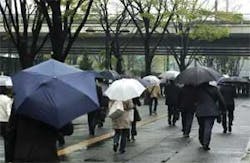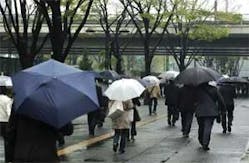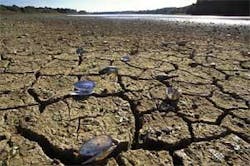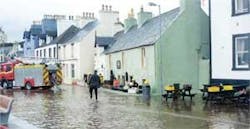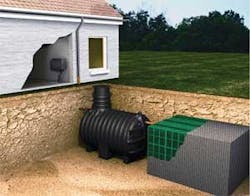Rainwater harvesting systems offer another opportunity for more efficient use of water resources that help to relieve the problems of both drought and flooding.
By Chris Williams
Former UN Secretary General Kofi Annan stated in his address to the Third World Water Forum in Japan in 2003 that, while water problems are most acute in the developing world, developed counties are also at risk. Here, he puts his finger on the problem of managing water resources for the world’s rapidly increasing and industrialising population as a global issue – one made more acute by climate change.
Too often in England, there’s the perception we have plenty of water and most countries in hotter regions have less – with a few subjected to periodic unwelcome amounts of water falling to create the contrary water problems of flooding.
In fact, bar the catastrophes caused by extreme bad weather (like flooding from recent cyclones in Bangladesh or tropical storms in Tabasco, Mexico), many water problems are interlinked to some degree. Appropriate water resource management can help alleviate both the constraints of drought and risk of flood.
Back in south England in 2006, drought orders were served on a disbelieving population. The truth is there’s more per capita water available in many Mediterranean and semi–arid countries like Syria and the Sudan than in some regions of the United Kingdom.
Rainwater harvesting solutions
The case for effective rainwater harvesting was launched with the Save the RainTM campaign. It and its website (www.savetherain.info) pinpointed the need for legally encouraged domestic rainwater harvesting for all of the UK’s projected new homes being built over the next decade, which would add to the load on water resources, especially in the South.
In 2007, of course, flooding was the problem and in the South of England. Again, poor water resource management at the point of rain falling was a major contributory factor. Widespread rainwater harvesting would certainly have smoothed out some of the peak volumes that overtopped the downstream defences.
In the developing world, the same problems apply but are exacerbated by lack of infrastructure, seasonality and the threat of disease; civil unrest and war also do not help. Water resource management tuned to the needs and resources of the local population is a demonstrably effective way of tackling the availability of water and the health of the population.
Tempering the flood risk
For example, deforestation in the Himalayas has long been cited as a major contributor to monsoon–fueled flooding down the Ganges and Bangladesh. A typical WaterAid (www.wateraid.org) project is based at a school in an urban slum area of Bharatpur Municipality in the Chjitawan District in Nepal.
Here, the rainwater harvesting installation will benefit around 900 students and 15 teaching staff. It’s also part of a wider project integrating water, sanitation and hygiene education work. Availability of a source of clean water relieves pressure on mains water resources – which were very limited in availability in the area anyway – and improves the success for incorporating sewage drainage. Beyond the immediate benefit, implementation of the programme will encourage the students and staff to spread the word about the advantages and hygienic practices to a wider audience, a useful way of disseminating the mantra for better public health.
Harvesting the rainwater also slows its runoff into the watercourses, exacerbated by the increasing urbanisation in the area and reduction in vegetative cover. If rainwater harvesting was taken up across Nepal to offset the deforestation and reduction in ground covering vegetation, the flood risk down stream would be alleviated.
Dry and wet seasons
Looking at the many countries where limited aboveground water is contrasted with extensive underground supplies, often the rainy season is short and intense resulting in some water lost to runoff (which when too heavy turns into flash flooding) and then evaporation. Water shortages are usually attacked by installing pumps for everything from domestic water to agriculture. Hygiene problems caused by lack of water and sanitation are frequently made worse by sharing facilities like wells and water holes with domestic animals, resulting in parasitic infections and insect–borne disease.
Here, rainwater harvesting also can be used as a supplementary solution to pumping. It traps rainwater near the point of falling, holding it back as a clean source which can be separated from agricultural use for as long as it lasts. It can also reduce the waste of flash flooding and evaporation. Even a solution for part of the year reduces the strain on groundwater resources and pumping requirements, and would help spread out the supply over the wet/dry seasonal cycles.
It’s arguable whether even in countries well supplied with water like rice–growing areas of the world, much better hygiene could be achieved with recycled rainwater for the population for cooking/drinking rather than using the local river or ditch.
Urban & commercial solutions
In the many areas of the world – Africa, India, South America – where urban growth out accelerates infrastructure growth, introducing rainwater harvesting schemes to schools, community centres, cooperative factories and other enterprises as part of general hygiene and sanitation schemes would bring immediate benefits. Just as in the Bharatpur, Nepal, project, the knock–on effect for the general population and the relief to what infrastructure exists would magnify the benefit far beyond the initial investment.
Author’s Note:
Chris Williams is European managing director for Hydro International, a USA–based company with offices in the U.K. and Ireland. For further information on Save The Rain or the Hydro StormBankTM rainwater harvesting system, contact +44(0) 1275 337977, [email protected] or www.savetherain.info
